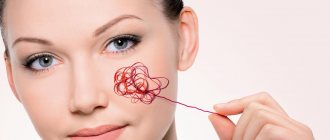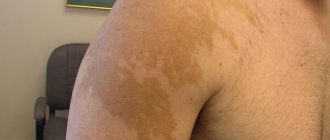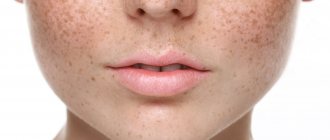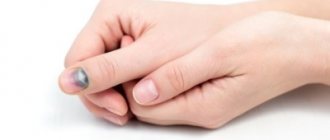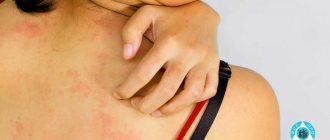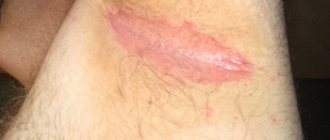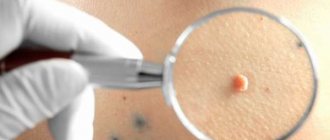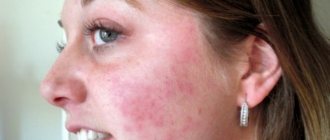The appearance of spots with a hint of hyperemia on the surface of the body is an indicator of a reaction to an existing irritant, which may be alcohol. The color of the emerging spot is formed due to the protrusion of the walls of a small capillary network located in the layers of the skin. When they narrow, the integuments turn pale, and when they expand, a corresponding shade appears.
The formation of limited redness is also influenced by a person’s skin type. In blondes and redheads, the capillary network is located very close to the surface, so redness forms quickly and more clearly. This type of person suddenly turns pale or turns red. The formation of spots on the face from alcohol is a pathological disorder and requires clarification of the causes that create it.
Main causes of redness
In the process of narrowing of the vascular network, an outflow of blood is observed, as a result of which the shade of the integument turns white and red with a significant expansion of the vascular lumen. When exposed to ethanol, the main component of alcohol-containing drinks, changes occur inside the body in which small vessels not only dilate, but also partially block their blood flow. This is due to biochemical processes leading to the gluing of red blood cells.
The course of the internal process when drinking alcohol leads to the formation of spots, and first of all they appear on the face, since in this area the integument is thinner and more delicate than on other parts of the body. The manifestation of clear signs of an existing pathological deviation is based on several factors, which include the following:
- natural vascular reaction to the appearance of ethanol in the bloodstream;
- hereditary intolerance to alcohol-containing liquids, including their individual components;
- allergenic manifestation of the body's response;
- consequences of long-term alcohol consumption with a protracted form of addiction to it.
With chronic alcoholism, the face may become flushed even after drinking minimal doses of alcohol.
Option two: false allergy
Often, after drinking alcohol, the face becomes covered with red spots precisely due to pseudo-allergy. It differs in that the face turns red as a result of drinking a large amount of alcohol (for a true allergy, a few drops are enough). The spots appear irregularly, but their occurrence, as with classic allergies, can be associated with skin itching. Allergy tests give a negative result. This is due to the fact that in this case, alcohol directly promotes the release of substances that cause redness of the facial skin, without affecting the immune system.
Symptomatic treatment differs little from true allergies: you will need to take antihistamines. In this case, there is no need to completely abstain from alcoholic beverages. However, this is a serious reason to think about changing your lifestyle and reducing the amount of alcohol consumed. Typically, this may be enough to make red spots on the body and face disappear forever.
Photo of alcohol stains on face
If redness appears
If your face turns red after drinking alcohol, then self-medication and taking medications without the consent of a doctor is prohibited. Treatment is selected individually depending on the underlying cause. If the causative factor is an allergy, then redness may appear after a specific type of alcohol. Therefore, when changing the drink, the reaction disappears.
To avoid getting covered in bright plaques after a small dose, there are two ways to fight it. The most effective is to exclude any type of alcohol. But people with alcohol addiction are unable to fulfill this condition. In this case, you must adhere to the basic rules:
- drink high-quality drinks without chemical and synthetic additives;
- do not abuse alcohol and use moderation;
- find the safest drink for yourself;
- If redness occurs, consult a doctor.
If bright rashes appear after drinking alcohol, treatment should be carried out strictly under the supervision of a doctor. First of all, it is necessary to neutralize toxic and poisonous substances. For mild symptoms, you can drink kefir or yogurt. But if the spots merge with each other and the redness spreads to the neck and shoulders, then the patient’s blood is purified with the help of droppers.
Medicines will help remove allergens and toxic substances from the body. Sorbents cope with this task: Polysorb, Enterosgel, Polyphepan and activated carbon . Before taking the medicine, you should study the instructions, as some of them are incompatible with alcohol.
Instead of sorbents, you can take an antihistamine: Zodak, Suprastin, Cetrin or Lomilan. Before using them, you should rinse your stomach. To do this, the patient should be given about 2 liters of water to drink. Essliver Forte will help remove toxins from the liver. You should drink it in courses for 2 months. Skin rashes can be treated with a decoction of mint, chamomile or calendula.
Skin changes after drinking alcohol are a signal that indicates that there are problems in the body. This can be either a local failure or a serious illness. To get rid of reddish spots, you need to find out what caused their formation.
Mechanism of vascular response
The components of alcohol-containing drinks, entering the body and then being absorbed through the mucous membrane of the digestive tract, inevitably enter the bloodstream and, with its current, are carried throughout all internal structures and tissues. Ethanol has a stimulating effect on the blood flow system, activating the process. It is this that provokes a rise in the boundaries of internal vascular pressure, influencing the expansion of the lumen of blood vessels.
The capillary network reacts very first, and its close location to the outer integument is detected visually as the appearance of red spots on the face from alcohol . Most often, such an external reaction goes away on its own, without causing any particular inconvenience, but not all processes in the body against the background of interaction with ethanol disappear without a trace.
Causes of a red nose in alcoholics
A red nose is another distinctive feature of alcoholics. Let's find out why the nose turns red, and not the other part of the matter, what are the causes of the phenomenon? According to Professor Zhdanov’s lecture, alcohol entering the body causes red blood cells to stick together. Since there are a lot of tiny vessels on the nose that branch, a blockage forms at the branching points. As a result of the blockage, the vessel swells and begins to die, since the phenomenon occurs in many vessels at once, the alcoholic’s nose gradually becomes red with a bluish tint and swells. The “red nose” itself is not dangerous: the effect of alcohol on internal organs is much more dangerous. To form changes on the face, a person must abuse it for quite a long time, which means that at the time the nose turns red, the internal organs are in a rather deplorable state.
As a result of blockage of blood vessels, the nose of an alcoholic becomes red with a bluish tint and swells.
The danger of internal violations
When localized areas of redness spread on the integument after the face throughout the body, it indicates a disruption in the functionality of the following systems:
- circulatory: vascular changes are observed in the tissues of the network;
- metabolic: the synthesis of a sufficient concentration of enzymes that promote the breakdown of alcohol for its subsequent disposal from the body is disrupted;
- nervous: the effect initially stimulates the activity of the system, then inhibits it more intensively;
- digestive: there is a change in the function of the complete breakdown of nutrients entering the body while drinking alcohol.
This category of people should think about the relationship between the effect of pleasure and the harmful effects on their own body. The best option would be to completely abstain from drinking such drinks, and their level of strength does not have a significant impact, since in any case the reaction development mechanism is triggered in exactly the same way.
If you do not notice the appearance of spots on the face after alcohol, which the body signals, involving only the superficial integument, the reaction can, depending on the duration of the intake interval, lead to intoxication poisoning and the occurrence of serious functional problems.
How to get rid of the problem
Alcohol intolerance and its manifestation in the form of a reaction to most drinks is the first step to thinking about contacting a specialist. The doctor collects anamnesis in order to identify and exclude the source of exposure to the body.
When the substance is detected, the doctor will tell you what to do at home if this happens again. But not in all cases such a simple approach will have an effect.
The following symptoms, which appear simultaneously with redness, will require a more serious attitude to the problem:
- tachycardia;
- suffocation;
- Strong headache;
- swelling of the face and limbs.
When a person becomes covered with red spots and exhibits at least a few of the signs from the list, he urgently needs to stop the feast and start drinking non-alcoholic liquid. At the same time, it is necessary to find out exactly what drink was drunk. In the future, this will help to understand what exactly is the main source of negative manifestations in the body.
When it became clear what substance causes redness of the face and body, it is forever excluded from any menu for a person. Patients often react to drinks that contain essential oils or tannins, such as whiskey or tequila. In this case, it is recommended to replace them with “cleaner” alcohol – vodka or high-quality cognac.
Allergies and intolerances
For this reason, the appearance of visual redness on the face can be detected not only at the time of drinking an alcohol-containing drink, but also at some interval after. In this case, the dosage of the drink or its strength does not matter at all. The reaction occurs with the following symptoms:
- Spots of hyperemia appear on the face and subsequently spread over the entire surface of the body.
- The level of vascular pressure increases sharply.
- Swelling and puffiness of facial tissues appears.
- The stage of intoxication occurs very quickly, even with a small dosage of the drink.
- The respiratory cycle is disrupted, resulting in signs of lack of air and discomfort.
- Blood rushes to the head, provoking the development of pain symptoms.
After removing the irritating factor from the body, the signs of an allergenic reaction completely disappear. Therefore, to eliminate the possible occurrence of more dangerous consequences, such as the development of a state of shock, even with the initial appearance of slightly pink spots on the face from alcohol, you should immediately stop drinking and think about whether it is worth risking your own life later!
Possible complications
If a person, having congenital intolerance to alcohol or allergies, still drinks alcohol-containing drinks, then over time, damage to the liver and stomach occurs. The risk of developing malignant tumors also increases significantly.
Heart disease is only worsened by the influence of ethanol. The heart wears out quickly, new pathologies appear, and the risk of developing myocardial infarction increases significantly. Due to the destruction of blood vessels, the likelihood of a cerebral stroke increases.
Chronic form of the course
With this form of craving for alcohol, a person’s outer skin suffers more intensely, sharply exacerbating the aesthetics of external parameters. This occurs against the background of extensive death of sections of the capillary network, forming the appearance of a typical bluish tint of the integument. With prolonged consumption of alcoholic beverages, the following processes are observed:
- the functionality of vascular blood flow deteriorates;
- red blood cells undergo massive clumping;
- the vessels overlap;
- pressure parameters have an abrupt form with a tendency to a steady increase;
- ruptures of the vascular wall are observed with the formation of hemorrhages up to the development of a stroke.
With long-term use of alcohol-containing drinks, the appearance of facial hyperemia occurs frequently and may even remain, practically without disappearing. Internal disorders affect all systems and organs, creating an imbalance in their activity with the development of pathological conditions. Functionally, the human body is not designed to process alcohol-containing components, which, when ingested, cause irreparable harm not only to the state of the body, but also to the consciousness and perception of a person.
Treatment of allergies to alcoholic drinks
Red spots on the face
Before starting full treatment of the patient, it is necessary to carry out a set of general therapeutic measures. After this, it is allowed to move on to the use of both special medications and traditional medicine.
First aid
Move the victim out into the fresh air
The measures taken in this case are in many ways similar to those taken in case of intoxication with alcoholic beverages. If the victim remains conscious, he needs to rinse the stomach with cool water as quickly as possible. If possible, induce vomiting or give an enema. During vomiting, the patient should not be left in a lying position, as this risks choking on the vomit. If the patient begins to experience swelling of the mucous membrane and/or hyperemia, under no circumstances should he be allowed to fall asleep. It is advisable to force him into a sitting position. If possible, you should go out with the victim into fresh air.
It is allowed to give the victim an enterosorbent or make an intramuscular infection of an antihistamine. If after this the swelling continues to increase, use Prednisolone or similar drugs.
Additional Information. If suffocation begins, then proceed to the use of an anti-asthma inhaler.
If, as a result of the actions taken, it was not possible to improve the victim’s condition, it is necessary to call an ambulance as quickly as possible.
Use of medications
If an allergy to alcohol is hereditary, the patient, as a rule, is aware of this feature of the body and does not drink alcohol. However, sensitization can also occur accidentally. Thus, ethanol can be one of the ingredients of medicines, and can also be used in the preparation of dessert products. In this case, the method of treating the victim depends on the clinical picture.
Glucose
Usually, when the first symptoms appear, adult patients are given enterosorbent drugs that can eliminate intoxication: Atoxil, Polysorb, as well as similar products: white carbon, activated carbon or Smecta. In some cases, it is necessary to resort to infusion of drugs such as:
- glucose;
- hemodesis;
- sodium chloride;
- disol.
To quickly restore the patient’s normal condition, it is necessary to give him third or fourth generation antihistamines, which are distinguished by the absence of a sedative effect. These include Cetirizine, as well as its analogues:
- Bamipin;
- Loratadine;
- Ebastine.
If a patient has developed a pseudo-allergy, characterized by respiratory manifestations, it can be removed using such means as:
- Allergodil;
- Momat Rhino Advance;
- Vibrocil.
Vibrocil
Effective means in this case are their analogues:
- Avamis;
- Histimet;
- Nasonex.
Skin itching and irritation are relieved with the help of such means as:
- Fenistil gel;
- Dermadrin;
- Psilo-balm;
- Ketocin.
Hormonal ointments are not allowed for use during the first day after drinking alcohol. If the swelling quickly increases and the itching becomes acute, an exception is made for Gistan ointment.
Victims often scratch the skin rash and provoke the development of a bacterial infection. In this case, treatment should be supplemented with antibacterial agents or ointments that can speed up the restoration of the skin:
- Povidone-Iodine;
- Rescuer;
- Bepanten.
Alcohol allergies are often accompanied by intestinal disorders. When removing them, the following remedies are effective:
- Lactium;
- Hilak forte;
- Bifiform;
- Subalin.
Often one of the symptoms of an allergy to alcohol is rapid intoxication. However, this is not a sign of sensitization and more indicates that a person’s dependence on strong drinks is increasing, and there is a possible risk of developing alcoholism.
Homemade folk remedies
Agrimony
Traditional medicine preparations are recommended for use in cases of minor redness of the skin of the face and other symptoms of an allergic reaction to alcohol. In this case, the disease will stop immediately after the body is cleared of metabolites formed as a result of the breakdown of ethanol.
The rapid removal of toxins is facilitated by the use of sage or yarrow decoctions, as well as chamomile-mint infusion. Dissolve 1 tablespoon of vegetable or herbal mixture in a quarter liter of water and mix the liquid thoroughly. After infusion, which lasts approximately a quarter of an hour, the liquid is brought to a boil for 5 minutes. The solution is poured through the filter and clean water is added so that the volume of the resulting product becomes 0.5 liters. The drink is consumed in equal portions several times a day.
Tubage helps to quickly cleanse the body of alcohol toxins. It contains plants that have a choleretic effect:
- celandine;
- agrimony;
- nettle;
- immortelle;
- dandelion (flowers);
- rosehip (root);
- chicory.
2 tablespoons of the plant mixture are dissolved in a thermos, into which 0.5 liters of boiling water has previously been poured. The liquid is kept in a closed thermos for 8 hours, after which you drink 1 glass of the drink on an empty stomach. The patient is placed on the right side with a warm heating pad applied to the liver. After 20 minutes, the victim should drink another glass of the folk remedy and perform several twists (turns of the body around the waist). A similar procedure is carried out once every 5 days. It is usually possible to return to normal after an allergy attack after 15-20 days.
During the day you need to drink at least 2.5 liters of liquid. Suitable drinks in this case are:
- still mineral water;
- cabbage or carrot juice;
- green tea without sugar;
- rosehip decoction.
Preventing the appearance of red spots
As already mentioned, if you are allergic to ethyl alcohol, you need to completely abstain from alcohol. But in most cases, the issue is not alcohol intolerance in general, but a reaction to one or another component or to exceeding the permissible dose.
To avoid this unpleasant phenomenon, you need to drink alcohol in moderation, and the drinks must be of good quality, made using the right technology and natural ingredients. Expensive, high-quality alcohol, if consumed in moderation, will only bring health benefits.
